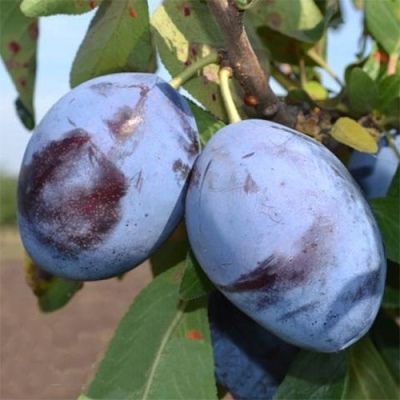
- Authors: USA
- Growth type: medium-sized
- Crown: not thick
- Fruit size: large or very large
- Fruit weight, g: 70-110
- Fruit shape: wide, slightly elongated oval
- Fruit color: violet-blue
- Skin : not thick, with a slight waxy coating
- Pulp (consistency): fleshy, dense, with a lot of juice
- Pulp color : yellowish
Plum Empress, although not in the official register of the Russian Federation, may be a good candidate for private gardens. However, to be successful, it needs to be well studied. And it's worth starting with the origin and general characteristics of this variety.
Breeding history
There is no exact information about the breeding of such a culture and its authors. It is known, however, that the Empress plum is originally from the USA.
Description of the variety
Empress is a versatile home plant. The demand for it is growing rapidly. This plum forms medium-sized trees. Remarkably, their crown is never thick. In shape, it resembles a wide oval.
Other features:
spreading of the top;
curved shoot development;
high level of general immunity.
Fruit characteristics
The Empress women of one class are large or even very large. Their mass can range from 70 to 110 g. Other important nuances:
wide shape (mainly in the form of an elongated oval);
violet-blue color;
medium-sized fruit stone, perfectly separable from the pulp;
storage possibility up to 12-14 days;
relatively thin rind with a moderately pronounced waxy bloom.
Taste qualities
The yellowish flesh of the Empress variety is fleshy and dense. It contains a large amount of juice. It feels like a sweet-sour fruit. They also have a pleasant aroma. The average tasting score is 4.8 points.
Ripening and fruiting
Empress is usually referred to as late plums. The harvest time usually comes in mid-September. If the plant begins to bear fruit, it will do so with enviable regularity. Violation of such a rule is associated either with poor care, or with extremely nasty weather. Usually, the first fruits are harvested in the second year of development.

Yield
The productivity level of this variety is very high. With plantation cultivation, the yield reaches 380 centners per 1 hectare. Basically, the harvested crop is used fresh. And also it can be processed, getting compote, jam. Freezing of fruits for the winter is also possible.
Self-fertility and the need for pollinators
This variety is characterized by limited self-fertility. Without the assistance of other plants, it will hardly be possible to count on a decent harvest. As pollinators, planting material suppliers generally offer:
Stanley;
Chachak lepotics;
The President;
Blue fries.
Growing and caring
Even the most experienced gardeners do not come up with anything especially specific for this variety. Pruning Empress, like any other fruit plants, must be carried out without fail. Already at the time of planting, it is worth getting rid of shoots 40-45 cm long. Every year, all dry, diseased and mechanically damaged areas are removed. Young plants require not only active, but regularly produced watering.
During the dry period, you need to pour 15-20 liters of water at least 2 times a week.If the weather is not hot, you can limit yourself to 10 liters of water per week. To keep moisture better, the trunk circle should be mulched. It is necessary to loosen the soil regularly, but to a shallow depth. These simple guidelines will almost always lead to success.




Disease and pest resistance
It is officially announced that this variety does not suffer from moniliosis. Clasterosporium also poses no particular threat. However, the most correct strategy will still be the maximum prevention of all kinds of ailments. No specific pests have been described. By default, insect control is the same as for other plum trees; judging by the reviews on the forums, the aphid attacks less often than the scale insect.

Despite the fact that plum is considered more hardy than many fruit trees, it is not immune from diseases. It is attacked by viral, fungal and bacterial infections, and parasitic insects harm it. It is necessary to notice and recognize the signs of plum disease in time. They are easier to deal with and defeat early on. Well, in order to protect the garden tree from such a misfortune in the future, preventive procedures can be carried out.
Resistance to soil and climatic conditions
Plum Empress is winter-hardy. It performs well at least in the Central Black Earth Region. Mostly flower buds freeze slightly. In more difficult areas (such as the Urals, the northwest or the Far East), planting this variety is very risky.



































































